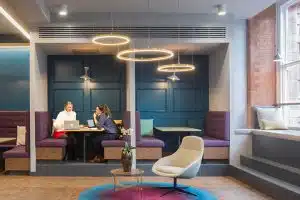Positive workplace culture is proven to help attract and retain talent, drive engagement, improve employee happiness and satisfaction, reduce absence and increase productivity, which ultimately all leads to better business performance. Backing this up, stats from our recent research of UK office workers revealed:
• A positive company culture is important to 95.8% people.
• 67.4% of people would change jobs for a better company culture.
• Fewer than 6% of people would rate their organisation as excellent when it comes to company culture.
Creating a thriving company culture is easier said than done though, and is influenced by everything from leadership and management, through to policies, people and the workplace environment. While culture isn’t something you can dictate, considered office design choices can help steer your culture in the right direction…
1 Openness and connectivity
By designing your office to be more open, you can promote a collaborative and supportive work environment, encourage teamwork and create shared experiences, which is really important to developing a strong company culture.
Minimise cellular spaces and instead focus on a series of connected spaces, with few corridors or barriers. The use of glazing as doors and walls maximises the feeling of openness but still allows for enclosed spaces to be created for meetings. Agile workplace settings also support with this by encouraging people to work alongside people from other teams who they may not typically spend time with, building cross-team communication and supporting relationship building.
2 Branding
Branding of a workspace offers the ideal opportunity to help you capture and cultivate culture. When people arrive into your office, they should know immediately what your company is all about. Equally, people working in the office should have a sense of belonging to the company they work for.
The chosen colour scheme should reflect your brand palette, to give a sense of identity wherever people are in the space. Fonts and colours used on signage should also follow the brand guidelines to create a sense of familiarity and consistency. Your company logo and brand values should also be visible – these could be incorporated onto bold and playful wall graphics or on glazing manifestation, or more subtly into flooring and lighting features for example. Clever selection of finishes is also a subtle way that you can foster the culture you want to create.
3 Employee wellbeing
Unsurprisingly, 92.8% of people we spoke with in our research agreed that their wellbeing is important to them when at work. Considered office design can support mental and physical wellbeing in many ways. Providing an agile environment with a range of work settings gives people the autonomy to work how and where they want to do best. Research has shown that giving employees autonomy also reduces stress and increases happiness.
In addition, ensuring there is plenty of access to natural light, providing thermal and acoustic comfort, and access to fresh air through proper ventilation, will all aid wellbeing and boost overall comfort and morale. The incorporation of multi-faith and wellness rooms will also support inclusivity as well as health and wellbeing.
4 Socialising and collaboration
Providing areas for employees to interact and connect beyond work tasks is instrumental in shaping and nurturing company culture; gyms, games rooms and communal areas, and refreshment points, can all help to create an ideal informal setting for this purpose.
The design of collaboration zones will vary depending on your specific business needs, however, typically include ergonomic and comfortable seating and flexible workstations.
Strategically placed media/project boards and display surfaces can also be used to boost creativity and innovation, and allow people to share and learn from others’ ideas, encouraging a culture of teamwork and innovation.
What about the impact of hybrid working?
There is no doubt the pandemic highlighted the ability for many people to work from home, but it has also emphasised the advantages of having a team working together in one location. From increased collaboration opportunities, insights, gathering and knowledge sharing with colleagues over spontaneous water cooler moments, what may feel like ‘down time’, can actually prove extremely valuable and lead to new ideas, increased efficiencies and productivity, stronger relationships and improved culture.
When people are in the office, they can feel the energy of being together and experience a sense of common purpose, which in turn has many benefits. Almost 60% of people we spoke with during recent research agreed that it’s difficult to feel part of the company culture when working at home – despite the average worker saying they would prefer to work from home for almost half of the week. 64% of people also agree it is hard for employers to build a positive company culture when people are working from home. Now the dust has settled following an almost overnight shift in working patterns, business leaders need to assess if and how their culture has been impacted and consider how to make any improvements.
How can you create a culture and workplace environment which encourages people into the office, and where the commute is not seen as a chore? Let’s talk.




